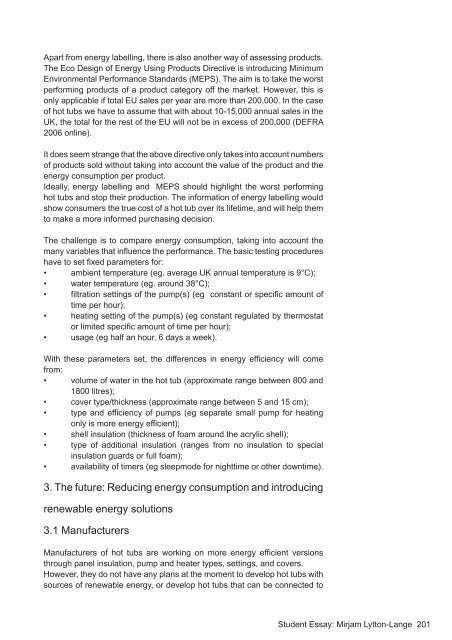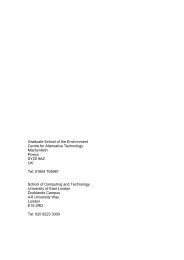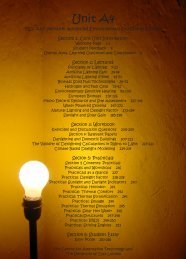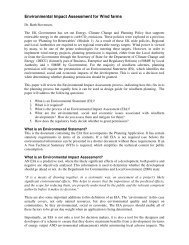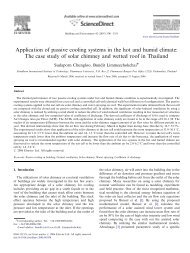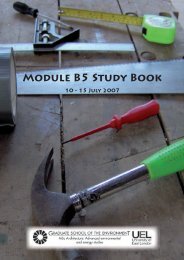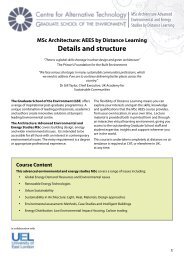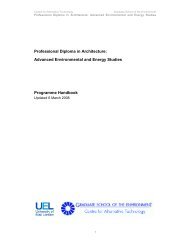Module B1 Study Book - the Graduate School of the Environment
Module B1 Study Book - the Graduate School of the Environment
Module B1 Study Book - the Graduate School of the Environment
Create successful ePaper yourself
Turn your PDF publications into a flip-book with our unique Google optimized e-Paper software.
Apart from energy labelling, <strong>the</strong>re is also ano<strong>the</strong>r way <strong>of</strong> assessing products.<br />
The Eco Design <strong>of</strong> Energy Using Products Directive is introducing Minimum<br />
<strong>Environment</strong>al Performance Standards (MEPS). The aim is to take <strong>the</strong> worst<br />
performing products <strong>of</strong> a product category <strong>of</strong>f <strong>the</strong> market. However, this is<br />
only applicable if total EU sales per year are more than 200,000. In <strong>the</strong> case<br />
<strong>of</strong> hot tubs we have to assume that with about 10-15,000 annual sales in <strong>the</strong><br />
UK, <strong>the</strong> total for <strong>the</strong> rest <strong>of</strong> <strong>the</strong> EU will not be in excess <strong>of</strong> 200,000 (DEFRA<br />
2006 online).<br />
It does seem strange that <strong>the</strong> above directive only takes into account numbers<br />
<strong>of</strong> products sold without taking into account <strong>the</strong> value <strong>of</strong> <strong>the</strong> product and <strong>the</strong><br />
energy consumption per product.<br />
Ideally, energy labelling and MEPS should highlight <strong>the</strong> worst performing<br />
hot tubs and stop <strong>the</strong>ir production. The information <strong>of</strong> energy labelling would<br />
show consumers <strong>the</strong> true cost <strong>of</strong> a hot tub over its lifetime, and will help <strong>the</strong>m<br />
to make a more informed purchasing decision.<br />
The challenge is to compare energy consumption, taking into account <strong>the</strong><br />
many variables that influence <strong>the</strong> performance. The basic testing procedures<br />
have to set fixed parameters for:<br />
• ambient temperature (eg. average UK annual temperature is 9°C);<br />
• water temperature (eg. around 38°C);<br />
• filtration settings <strong>of</strong> <strong>the</strong> pump(s) (eg constant or specific amount <strong>of</strong><br />
time per hour);<br />
• heating setting <strong>of</strong> <strong>the</strong> pump(s) (eg constant regulated by <strong>the</strong>rmostat<br />
or limited specific amount <strong>of</strong> time per hour);<br />
• usage (eg half an hour, 6 days a week).<br />
With <strong>the</strong>se parameters set, <strong>the</strong> differences in energy efficiency will come<br />
from:<br />
• volume <strong>of</strong> water in <strong>the</strong> hot tub (approximate range between 800 and<br />
1800 litres);<br />
• cover type/thickness (approximate range between 5 and 15 cm);<br />
• type and efficiency <strong>of</strong> pumps (eg separate small pump for heating<br />
only is more energy efficient);<br />
• shell insulation (thickness <strong>of</strong> foam around <strong>the</strong> acrylic shell);<br />
• type <strong>of</strong> additional insulation (ranges from no insulation to special<br />
insulation guards or full foam);<br />
• availability <strong>of</strong> timers (eg sleepmode for nighttime or o<strong>the</strong>r downtime).<br />
3. The future: Reducing energy consumption and introducing<br />
renewable energy solutions<br />
3.1 Manufacturers<br />
Manufacturers <strong>of</strong> hot tubs are working on more energy efficient versions<br />
through panel insulation, pump and heater types, settings, and covers.<br />
However, <strong>the</strong>y do not have any plans at <strong>the</strong> moment to develop hot tubs with<br />
sources <strong>of</strong> renewable energy, or develop hot tubs that can be connected to<br />
Student Essay: Mirjam Lytton-Lange 201


